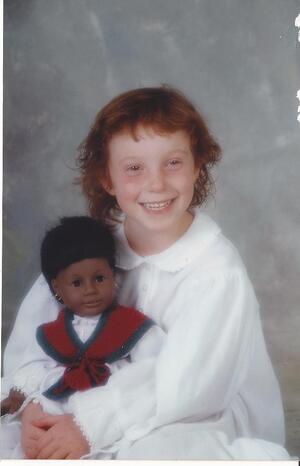Freedom Stories
This month our Rising Voices Fellows explore their relationships to Passover traditions. Be sure to check the JWA blog each Tuesday for a new post from our fellows—and check out the great educational resources provided by our partner organization, Prozdor.
The first books I ever fell in love with were the American Girl books. The American Girl Company as a whole was a big part of my childhood, and its influence is still with me today: if it weren’t for it and Billy Joel’s “We Didn’t Start The Fire,” I don’t know if I would have passed US History last year. Educational value aside, the books have held up as fantastic examples of children’s literature, with their beautiful illustrations, interesting historical notes in the margins, diverse characters (including their cast of thirteen young female protagonists), and, most importantly to me, simple but solid stories.
When most people think of the American Girls, I’m sure their minds go straight to the dolls. The dolls are great as supplements to the books, but they’re pretty darn expensive, and no matter how much of an enthusiast you are, it’s not practical to buy more than one or two. I have had mine since I was six, and I remember how carefully I decided which one was my favorite.
There were seven historical characters back then: Felicity, Josefina, Kirsten, Addy, Samantha, Kit, and Molly. If the Jewish character, Rebecca, had been around, I might have picked her. But then again, maybe I wouldn’t have. Felicity was a redhead like me, so she was probably the more obvious choice. But I didn’t pick her. In the end, I did not make my decision based on the doll’s background or what she looked like. My favorite American Girl might seem like the most unlikely choice, but her story spoke to me the most. To this day, I don’t think I’ve met another girl who loved her as much as I do: Addy Walker, at the time the only African-American character of the bunch.
The first book in Addy’s series read to me like a thriller; the story was so exciting and suspenseful that I was literally pacing my room as I read it. It concerned Addy and her mother’s escape from slavery on a Southern plantation, with elements such as a run-in with Confederate soldiers who don’t know they’re fugitives and Addy saving her mother from drowning in rapids. I breathed a huge sigh of relief when they finally reached the “safe house,” and although I knew that the next book would show them living safely in Philadelphia, I was so awed by Addy’s bravery through the ordeal of escape that I was eager to read more about her.
Incidentally, this was the first time I had ever heard of the Underground Railroad, a phrase that I would see again many times, usually in history class but just as often as an analog to the story of Exodus. I mentioned in my post in February that I’m a bit of a biblical skeptic. I had already participated in six Passovers when I read the Addy books, and although Miriam is one of my heroes and although I love Seders and reading the Haggadah, there was just something about this “exodus” from the South that made it seem more real, more sad, more harrowing. It was the first story of freedom that really broke through to me. And that is really important.
Why is Passover such a defining holiday for Judaism in the first place? I think it’s because everyone loves a freedom story. More specifically, everyone likes to see the protagonist freeing themself from their oppressors, which is good; any story with a conflict is essentially a variation on that theme. There’s something especially powerful about a literal escape, especially one that brings together an entire culture. And that’s something that the stories of both Passover and the Underground Railroad share.
Beyond culture, however, everyone should have their own favorite freedom story, one that means something to them personally. Some are content with those bigger stories. But then there are people who need the story of an individual, whether real or fictional or (in my case) plastic. Addy’s was the first freedom story I ever read on my own, and it is one I will never forget.
This piece was written as part of JWA’s Rising Voices Fellowship.






